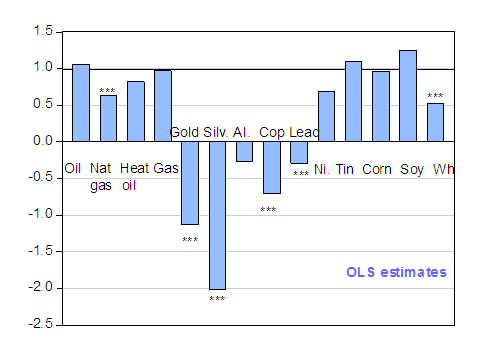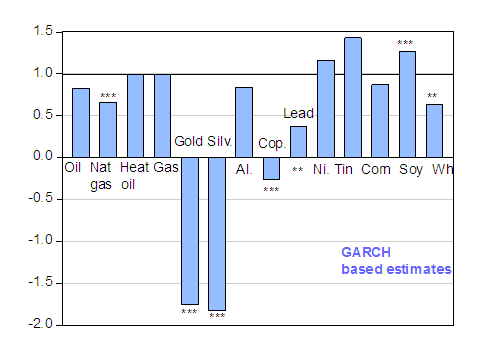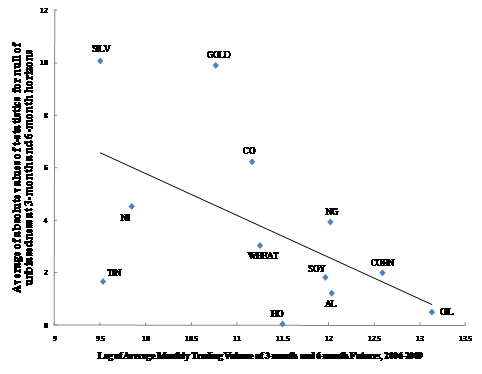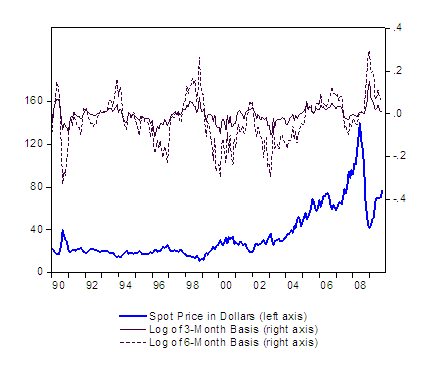Econbrowser readers will know that I’ve long been interested in how derivatives like futures predict commodity prices. An early paper on energy futures, coauthored with my former CEA colleagues Michael LeBlanc and Oli Coibion, was summarized in this 2006 post (paper here). Recently, Oli Cobion and I have updated and expanded our examination, to incorporate for the most recent data, account for GARCH effects, alloow for time variation, and to try to explain why there has been time variation in the deviations in the unbiasedness proposition.
From the abstract to our paper:
This paper examines the relationship between spot and futures prices for a broad range of commodities, including energy, precious and base metals, and agricultural commodities. In particular, we examine whether futures prices are (1) an unbiased and/or (2) accurate predictor of subsequent spot prices. While energy futures prices are generally unbiased predictors of future spot prices, there is much stronger evidence against the null for other commodity markets. This difference appears to be driven in part by the depth of each market. We find that over the last five years, it is much harder to reject the null of futures prices being unbiased predictors of future spot prices than in earlier periods for almost all commodities. In addition, futures prices do approximately as well as a random walk in forecasting future spot prices, and vastly outperform a reduced form empirical model.
The paper is also available as NBER Working Paper No. 15830.
The regression we run is:
st – st-k = β 0 + β 1 (f t|t-k – st-k) + ε t
Where st is the log spot price at time t, ft|t-k is the log futures price at time t-k that matures at time t. The resulting β coefficients at the three month horizons are displayed in Figure 1.

Figure 1: β1 coefficients, estimated via OLS. *** (**) denotes significantly different from unity at the 1% (5%) level, using HAC robust standard errors. Source: Chinn and Coibion (2010).
As Jim Hamilton has pointed out in a related context (e.g., Fed Funds futures) [1] [pdf], accounting for GARCH effects can be important, particularly when making inferences regarding unbiasedness. Hence, we re-estimate the equation to obtain the following coefficients:

Figure 2: β1 coefficients, estimated using GARCH. *** (**) denotes significantly different from unity at the 1% (5%) level. Source: Chinn and Coibion (2010).
What about what determines the deviation from the unbiasedness hypothesis? To assess whether there is a link between the depth of each market and how closely the no-arbitrage condition holds. Figure 15 plots the (log) average monthly volume of trades for each type of commodity (averaged across 3-month and 6-month futures) from 2006-2009 versus the average absolute value of the t-statistic for the null of unbiasedness for 3-month and 6-month futures for each commodity type. There is a clear negative correlation. Market depth appears empirically important.

Figure 3: Average of the absolute value of the t-statistics for the null of unbiasedness for 3-month and 6-month futures for each commodity against average monthly trading volume, in logs, between 2006 and 2009. See empirical estimates of Table 1 in the paper. Source: Chinn and Coibion (2010).
Finally, just so readers can see what the variables in question look like, I present a plot of what the basis at 3 and 6 months look like for oil, since the price of petroleum is perennially of interest.

Figure 4: Price of Petroleum, WTI, end of month (blue, left axis), and the log 3 (solid, right axis) and 6 (dashed, right axis) month basis. Source: Chinn and Coibion (2010).
By the way, our tests of unbiasedness — and corresponding results that fail to reject that hypothesis — should not be taken as implying that futures are always correct; just that they are on average correct. For one (historical) case where the futures pointed in the wrong direction, see J. Hamilton, “Was the Deflation During the Great Depression Anticipated? Evidence from the Commodity Futures Market” AER 1992.
See Jim’s more recent takes on commodity futures here and here; and here’s Scott Irwin’s guest post on commodity futures.
I have trouble understanding. If oil prices raise four out of five years and the futures market says they are going to raise four out of five years what does that mean?
All the futures market is saying that if spot prices are rising they are likely to continue rising. Conversely, if spot prices are falling they are likely to continue falling.
What I would like to see is a record of how often futures prices are able to correctly forecast a change in trend in spot prices. If they can not do that they are not telling me anything except what trend spot prices are telling me.
There’s an error in the paper which doesn’t affect the results but which should be corrected.
London Mercantile Exchange (LME)
is not right. It is the London Metals Exchange (LME).
(1) The conclusion that most commodity future prices are not unbiased predictor of future spot prices does not surprise me.
(2) That WTI was singled out as better predictor compared to others does surprise me. If you look at the price swing since 2008, no trader will take comfort of the relations between future prices and future spot prices.
(3) This relationship has significance in challenging the “efficient market” theory.
(4) It does do much to reveal the underlying mechanism in commodity market because it is not how the market works.
I’m not certain, but I believe I read about oil futures that go out something like 5 or 8 years. It’d be interesting to see what that has to say about the believed viability of alternatives. I think high oil prices are basically an indication that alternatives are no yet close to be viable and are not ready to be scaled up.
Menzie,
I doubt that it would have affected the overall conclusion, but I’m curious why you didn’t model the conditional heteroskedasticity as a Threshold GARCH (TGARCH) model rather than as a plain old vanilla GARCH model. A common intuition is that people’s reaction to commodity price shocks is not symmetric, which suggests a TGARCH approach.
I’m puzzled by this whole line of research. The futures price is linked by arbitrage to the current spot price. It is also linked to the future spot price by speculators, who will equate it to the expected future price. If arbitrage flows are strong enough and dominate, though, the futures price will contain no more information about the future spot price than the current spot price. (One would need some measure of speculative activity to capture any information about expectations of speculators.) So the fundamental question seems to be the strength of arbitrage flows. In many cases, they clearly dominate.
How did you handle the apparent changes in importance of security of future oil supply that occasionaly force the futures market into “backwardation”?
By the way, can you explain why stock futures are now in backwardation (and have been for some time)?’
Menzie,
I’ve always found it interesting (and strange) that commodity prices look very close to random walks without drift. Your results confirm this. Futures look like better predictors than past prices, but not much. ARIMA models are far worse.
Most theory I’m aware of suggests prices should be somewhat more mean or trend reverting. So I wonder: how well does a simple AR(1) do out-of-sample in comparison to unit root and futures models? Is this something you’ve looked at?
spencer: That’s a good idea. In my exchange rate work, I’ve used “direction-of-change” metrics. That could be done here.
Matthew: Thanks — we’ll fix in the paper.
aaron: While futures for oil exist out to 5 years, my understanding is that those markets are quite thin at those maturities.
2slugbaits: We thought that accounting for ARCH effects would be sufficient. I don’t know of any stylized facts that says the ARCH effects for commodity prices have thresholds, but we could test for that possibility.
don: I understand your logic; and by that same logic, the forward exchange rate should equal the expected future spot rate. But if there is any robust stylized fact in international finance, it is that the forward rate is a biased predictor of future spot rates.
Michael Roberts: When one freely estimates an AR(1) for most of these commodities, the AR(1) coefficient is typically indistinguishable from unity. We haven’t run a horse-race between futures and AR(1)’s, but suspect that the estimated AR(1)’s would do worse than random walk specs.
While commoditie prices look like they follow trends, they are not typically linear trends, but moving averages. Haven’t tried that approach, but it would be interesting. That gets into chartist territory.